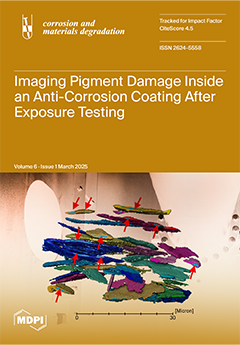The hydrolytic stability of thin poly(ethyl 2-cyanoacrylate), PECA, adhesive films on grit-blasted mild steel substrates was investigated using electrochemical impedance spectroscopy (EIS). Using this novel approach for such adhesive films, the effects of two additives, salicylic acid (SA) and phthalic anhydride (PA), were
[...] Read more.
The hydrolytic stability of thin poly(ethyl 2-cyanoacrylate), PECA, adhesive films on grit-blasted mild steel substrates was investigated using electrochemical impedance spectroscopy (EIS). Using this novel approach for such adhesive films, the effects of two additives, salicylic acid (SA) and phthalic anhydride (PA), were studied, specifically measuring their influence on polymer film/surface impedance and capacitance changes over a period of 14 days. Results indicate that SA decreased the polymer film hydrolytic stability rapidly, resulting in a substantial drop in impedance modulus from ~10 kΩcm
2 to ~10 Ωcm
2 at 100 Hz due to electrolyte ingress, whilst the PA-containing film modulus also diminished from ~4 MΩcm
2 to ~1 kΩcm
2 at 100 Hz. Furthermore, the capacitance values of the SA-containing films rose (up to ~100 µFcm
−2), demonstrating the onset of a charge transfer (corrosion) process within the first 12 h exposure to a saline electrolyte. In contrast, the PA-containing film’s transition from a film-dominated capacitance (~0.01 µFcm
−2) to a larger double-layer capacitance took (~1 µFcm
−2) took several days and was accounted for by differences in the additive’s chemistry, demonstrating the ability of EIS to detect changes in both bulk film (e.g., moisture ingress and bond scission) and metal-film interfacial processes (e.g., onset of corrosion) in real time. Comparison was also made with a standard industry combined tensile test/hydrolytic accelerated ageing regime. Unlike, EIS this did not, however, give useful time-dependent information, although after 6 weeks a decrease in bond strength occurred in the order PA-containing film < PECA< SA-containing film in agreement with the EIS results, thus demonstrating the effectiveness of EIS for monitoring the degradation of such thin film adhesives.
Full article





